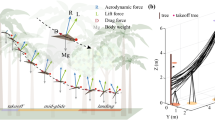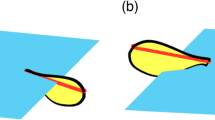Abstract
Despite their lack of appendages, flying snakes (genus Chrysopelea) exhibit aerodynamic performance that compares favorably to other animal gliders. We wished to determine which aspects of Chrysopelea’s unique shape contributed to its aerodynamic performance by testing physical models of Chrysopelea in a wind tunnel. We varied the relative body volume, edge sharpness, and backbone protrusion of the models. Chrysopelea’s gliding performance was surprisingly robust to most shape changes; the presence of a trailing-edge lip was the most significant factor in producing high lift forces. Lift to drag ratios of 2.7–2.9 were seen at angles of attack (α) from 10–30°. Stall did not occur until α > 30° and was gradual, with lift falling off slowly as drag increased. Chrysopelea actively undulates in an S-shape when gliding, such that posterior portions of the snake’s body lie in the wake of the more anterior portions. When two Chrysopelea body segment models were tested in tandem to produce a two dimensional approximation to this situation, the downstream model exhibited an increased lift-to-drag ratio (as much as 50% increase over a solitary model) at all horizontal gaps tested (3–7 chords) when located slightly below the upstream model and at all vertical staggers tested (±2 chords) at a gap of 7 chords.






Similar content being viewed by others
References
McGuire JA, Dudley R (2005) The cost of living large: comparative gliding performance in flying lizards (Agamidae: Draco). Am Nat 166(1):93–106
Jackson SM (1999) Glide angle in the genus Petaurus and a review of gliding in mammals. Mamm Rev 30(1):9–30
Ando M, Shiraishi S (1993) Gliding flight in the Japanese giant flying squirrel Petaurista leucogenys. J Mammal Soc Jpn 18(1):19–32
Scheibe JS, Robins JH (1998) Morphological and performance attributes of gliding mammals. In: Merritt JF, Zegers DA (eds) Ecology and evolutionary biology of tree squirrels. Virginia Museum of Natural History, Martinsville, pp 131–144
Vernes K (2001) Gliding performance of the northern flying squirrel (Glaucomys sabrinus) in mature mixed forest of Eastern Canada. J Mammal 82(4):1026–1033
Stafford BJ, Thorington RW, Kawamichi T (2002) Gliding behavior of Japanese giant flying squirrels (Petaurista leucogenys). J Mammal 83(2):553–562
Bishop KL (2006) The relationship between 3-D kinematics and gliding performance in the southern flying squirrel, Glaucomys volans. J Exp Biol 209(4):689–701
Yanoviak SP, Dudley R, Kaspari M (2005) Directed aerial descent in canopy ants. Nature 433(7026):624–626
Socha JJ (2002) Gliding flight in the paradise tree snake. Nature 418:603–604
Socha JJ, LaBarbera M (2005) Effects of size and behavior on aerial performance of two species of flying snakes (Chrysopelea). J Exp Biol 208(10):1835–1847
Socha JJ, O’Dempsey T, LaBarbera M (2005) A 3-D kinematic analysis of gliding in a flying snake, Chrysopelea paradisi. J Exp Biol 208(10):1817–1833
Hoerner SF (1965) Fluid-dynamic drag. Hoerner Fluid Dynamics, Brick Town
Spalart PR, Allmaras SR (1992) A one-equation turbulence model for aerodynamic flows. AIAA Conference Paper 1992–439, Reno, NV, pp. 1–22. (Aerospace Sciences Meeting and Exhibit, 30th, Reno, NV, Jan 6–9)
Hoerner SF, Borst HV (1975) Fluid-dynamic lift. Hoerner Fluid Dynamics, Brick Town
Spedding GR, Hedenstrom AH, McArthur J, Rosen M (2008) The implications of low-speed fixed-wing aerofoil measurements on the analysis and performance of flapping bird wings. J Exp Biol 211(2):215–223
Mueller TJ, DeLaurier JD (2003) Aerodynamics of small vehicles. Annu Rev Fluid Mech 35:89–111
Torres GE, Mueller TJ (2001) Aerodynamic characteristics of low aspect ratio wings at low Reynolds numbers, in fixed and flapping wing aerodynamics for micro air vehicle applications. Reston, AIAA, pp 115–141
Scharpf DF, Mueller TJ (1992) Experimental study of a low Reynolds number tandem airfoil configuration. J Aircraft 29(2):231–236
Michelsen WD, Mueller TJ (1987) Low Reynolds number airfoil performance subjected to wake interference from an upstream airfoil. AIAA Conference Paper 87–2351, Monterey, CA, pp 196–206. (AIAA Applied Aerodynamics Conference, Monterey, California, August 17–19, 1987)
Husain Z, Abdullah MZ (2005) Two-dimensional analysis of tandem/staggered airfoils using computational fluid dynamics. Int J Mech Eng Educ 33(3):195–207
Byrnes G, Lim NTL, Spence AJ (2008) Take-off and landing kinetics of a free-ranging gliding mammal, the Malayan colugo (Galeopterus variegatus). Proc R Soc, B Biol Sci 275(1638):1007–1013
Moon BR (1999) Testing an inference of function from structure: snake vertebrae do the twist. J Morphol 241(3):217–225
Acknowledgements
We thank Mark Stremler, Saad Ragab, and Mark Cramer for helpful discussions on the aerodynamic data in this study, and Pavlos Vlachos for a critical reading of the manuscript and advice. The comments of two anonymous reviewers greatly improved the manuscript. This project was part of an undergraduate honors research thesis (KM) at the University of Chicago; thanks to Heinrich Jaeger and Henry Frisch for their support and advice.
Author information
Authors and Affiliations
Corresponding author
Additional information
Michael LaBarbera and John J. Socha contributed equally to this work.
Rights and permissions
About this article
Cite this article
Miklasz, K., LaBarbera, M., Chen, X. et al. Effects of Body Cross-sectional Shape on Flying Snake Aerodynamics. Exp Mech 50, 1335–1348 (2010). https://doi.org/10.1007/s11340-010-9351-5
Received:
Accepted:
Published:
Issue Date:
DOI: https://doi.org/10.1007/s11340-010-9351-5




